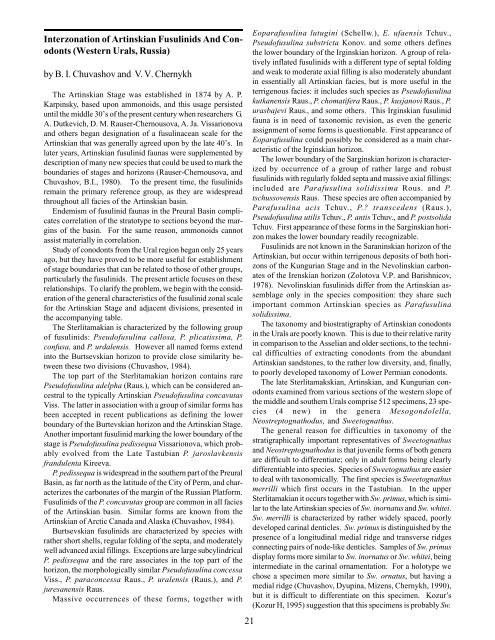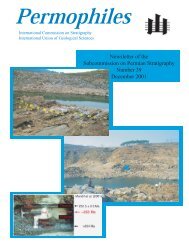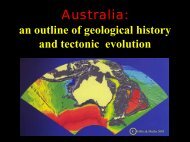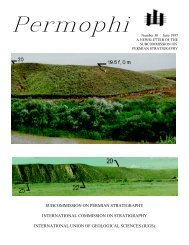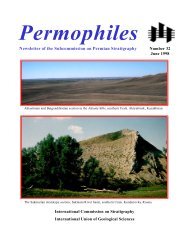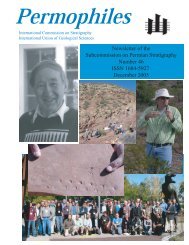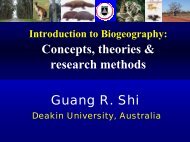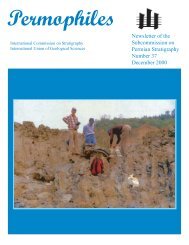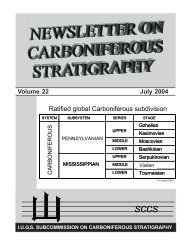Number 31 January 1998 Newsletter of the Subcommission on ...
Number 31 January 1998 Newsletter of the Subcommission on ...
Number 31 January 1998 Newsletter of the Subcommission on ...
Create successful ePaper yourself
Turn your PDF publications into a flip-book with our unique Google optimized e-Paper software.
Interz<strong>on</strong>ati<strong>on</strong> <str<strong>on</strong>g>of</str<strong>on</strong>g> Artinskian Fusulinids And C<strong>on</strong>od<strong>on</strong>ts<br />
(Western Urals, Russia)<br />
by B. I. Chuvashov and V. V. Chernykh<br />
The Artinskian Stage was established in 1874 by A. P.<br />
Karpinsky, based up<strong>on</strong> amm<strong>on</strong>oids, and this usage persisted<br />
until <str<strong>on</strong>g>the</str<strong>on</strong>g> middle 30’s <str<strong>on</strong>g>of</str<strong>on</strong>g> <str<strong>on</strong>g>the</str<strong>on</strong>g> present century when researchers G.<br />
A. Dutkevich, D. M. Rauser-Chernousova, A. Ja. Vissari<strong>on</strong>ova<br />
and o<str<strong>on</strong>g>the</str<strong>on</strong>g>rs began designati<strong>on</strong> <str<strong>on</strong>g>of</str<strong>on</strong>g> a fusulinacean scale for <str<strong>on</strong>g>the</str<strong>on</strong>g><br />
Artinskian that was generally agreed up<strong>on</strong> by <str<strong>on</strong>g>the</str<strong>on</strong>g> late 40’s. In<br />
later years, Artinskian fusulinid faunas were supplemented by<br />
descripti<strong>on</strong> <str<strong>on</strong>g>of</str<strong>on</strong>g> many new species that could be used to mark <str<strong>on</strong>g>the</str<strong>on</strong>g><br />
boundaries <str<strong>on</strong>g>of</str<strong>on</strong>g> stages and horiz<strong>on</strong>s (Rauser-Chernousova, and<br />
Chuvashov, B.I., 1980). To <str<strong>on</strong>g>the</str<strong>on</strong>g> present time, <str<strong>on</strong>g>the</str<strong>on</strong>g> fusulinids<br />
remain <str<strong>on</strong>g>the</str<strong>on</strong>g> primary reference group, as <str<strong>on</strong>g>the</str<strong>on</strong>g>y are widespread<br />
throughout all facies <str<strong>on</strong>g>of</str<strong>on</strong>g> <str<strong>on</strong>g>the</str<strong>on</strong>g> Artinskian basin.<br />
Endemism <str<strong>on</strong>g>of</str<strong>on</strong>g> fusulinid faunas in <str<strong>on</strong>g>the</str<strong>on</strong>g> Preural Basin complicates<br />
correlati<strong>on</strong> <str<strong>on</strong>g>of</str<strong>on</strong>g> <str<strong>on</strong>g>the</str<strong>on</strong>g> stratotype to secti<strong>on</strong>s bey<strong>on</strong>d <str<strong>on</strong>g>the</str<strong>on</strong>g> margins<br />
<str<strong>on</strong>g>of</str<strong>on</strong>g> <str<strong>on</strong>g>the</str<strong>on</strong>g> basin. For <str<strong>on</strong>g>the</str<strong>on</strong>g> same reas<strong>on</strong>, amm<strong>on</strong>oids cannot<br />
assist materially in correlati<strong>on</strong>.<br />
Study <str<strong>on</strong>g>of</str<strong>on</strong>g> c<strong>on</strong>od<strong>on</strong>ts from <str<strong>on</strong>g>the</str<strong>on</strong>g> Ural regi<strong>on</strong> began <strong>on</strong>ly 25 years<br />
ago, but <str<strong>on</strong>g>the</str<strong>on</strong>g>y have proved to be more useful for establishment<br />
<str<strong>on</strong>g>of</str<strong>on</strong>g> stage boundaries that can be related to those <str<strong>on</strong>g>of</str<strong>on</strong>g> o<str<strong>on</strong>g>the</str<strong>on</strong>g>r groups,<br />
particularly <str<strong>on</strong>g>the</str<strong>on</strong>g> fusulinids. The present article focuses <strong>on</strong> <str<strong>on</strong>g>the</str<strong>on</strong>g>se<br />
relati<strong>on</strong>ships. To clarify <str<strong>on</strong>g>the</str<strong>on</strong>g> problem, we begin with <str<strong>on</strong>g>the</str<strong>on</strong>g> c<strong>on</strong>siderati<strong>on</strong><br />
<str<strong>on</strong>g>of</str<strong>on</strong>g> <str<strong>on</strong>g>the</str<strong>on</strong>g> general characteristics <str<strong>on</strong>g>of</str<strong>on</strong>g> <str<strong>on</strong>g>the</str<strong>on</strong>g> fusulinid z<strong>on</strong>al scale<br />
for <str<strong>on</strong>g>the</str<strong>on</strong>g> Artinskian Stage and adjacent divisi<strong>on</strong>s, presented in<br />
<str<strong>on</strong>g>the</str<strong>on</strong>g> accompanying table.<br />
The Sterlitamakian is characterized by <str<strong>on</strong>g>the</str<strong>on</strong>g> following group<br />
<str<strong>on</strong>g>of</str<strong>on</strong>g> fusulinids: Pseud<str<strong>on</strong>g>of</str<strong>on</strong>g>usulina callosa, P. plicatissima, P.<br />
c<strong>on</strong>fusa, and P. urdalensis. However all named forms extend<br />
into <str<strong>on</strong>g>the</str<strong>on</strong>g> Burtsevskian horiz<strong>on</strong> to provide close similarity between<br />
<str<strong>on</strong>g>the</str<strong>on</strong>g>se two divisi<strong>on</strong>s (Chuvashov, 1984).<br />
The top part <str<strong>on</strong>g>of</str<strong>on</strong>g> <str<strong>on</strong>g>the</str<strong>on</strong>g> Sterlitamakian horiz<strong>on</strong> c<strong>on</strong>tains rare<br />
Pseud<str<strong>on</strong>g>of</str<strong>on</strong>g>usulina adelpha (Raus.), which can be c<strong>on</strong>sidered ancestral<br />
to <str<strong>on</strong>g>the</str<strong>on</strong>g> typically Artinskian Pseud<str<strong>on</strong>g>of</str<strong>on</strong>g>usulina c<strong>on</strong>cavutas<br />
Viss. The latter in associati<strong>on</strong> with a group <str<strong>on</strong>g>of</str<strong>on</strong>g> similar forms has<br />
been accepted in recent publicati<strong>on</strong>s as defining <str<strong>on</strong>g>the</str<strong>on</strong>g> lower<br />
boundary <str<strong>on</strong>g>of</str<strong>on</strong>g> <str<strong>on</strong>g>the</str<strong>on</strong>g> Burtevskian horiz<strong>on</strong> and <str<strong>on</strong>g>the</str<strong>on</strong>g> Artinskian Stage.<br />
Ano<str<strong>on</strong>g>the</str<strong>on</strong>g>r important fusulinid marking <str<strong>on</strong>g>the</str<strong>on</strong>g> lower boundary <str<strong>on</strong>g>of</str<strong>on</strong>g> <str<strong>on</strong>g>the</str<strong>on</strong>g><br />
stage is Pseud<str<strong>on</strong>g>of</str<strong>on</strong>g>usulina pedissequa Vissari<strong>on</strong>ova, which probably<br />
evolved from <str<strong>on</strong>g>the</str<strong>on</strong>g> Late Tastubian P. jaroslavkensis<br />
frandulenta Kireeva.<br />
P. pedissequa is widespread in <str<strong>on</strong>g>the</str<strong>on</strong>g> sou<str<strong>on</strong>g>the</str<strong>on</strong>g>rn part <str<strong>on</strong>g>of</str<strong>on</strong>g> <str<strong>on</strong>g>the</str<strong>on</strong>g> Preural<br />
Basin, as far north as <str<strong>on</strong>g>the</str<strong>on</strong>g> latitude <str<strong>on</strong>g>of</str<strong>on</strong>g> <str<strong>on</strong>g>the</str<strong>on</strong>g> City <str<strong>on</strong>g>of</str<strong>on</strong>g> Perm, and characterizes<br />
<str<strong>on</strong>g>the</str<strong>on</strong>g> carb<strong>on</strong>ates <str<strong>on</strong>g>of</str<strong>on</strong>g> <str<strong>on</strong>g>the</str<strong>on</strong>g> margin <str<strong>on</strong>g>of</str<strong>on</strong>g> <str<strong>on</strong>g>the</str<strong>on</strong>g> Russian Platform.<br />
Fusulinids <str<strong>on</strong>g>of</str<strong>on</strong>g> <str<strong>on</strong>g>the</str<strong>on</strong>g> P. c<strong>on</strong>cavutas group are comm<strong>on</strong> in all facies<br />
<str<strong>on</strong>g>of</str<strong>on</strong>g> <str<strong>on</strong>g>the</str<strong>on</strong>g> Artinskian basin. Similar forms are known from <str<strong>on</strong>g>the</str<strong>on</strong>g><br />
Artinskian <str<strong>on</strong>g>of</str<strong>on</strong>g> Arctic Canada and Alaska (Chuvashov, 1984).<br />
Burtsevskian fusulinids are characterized by species with<br />
ra<str<strong>on</strong>g>the</str<strong>on</strong>g>r short shells, regular folding <str<strong>on</strong>g>of</str<strong>on</strong>g> <str<strong>on</strong>g>the</str<strong>on</strong>g> septa, and moderately<br />
well advanced axial fillings. Excepti<strong>on</strong>s are large subcylindrical<br />
P. pedissequa and <str<strong>on</strong>g>the</str<strong>on</strong>g> rare associates in <str<strong>on</strong>g>the</str<strong>on</strong>g> top part <str<strong>on</strong>g>of</str<strong>on</strong>g> <str<strong>on</strong>g>the</str<strong>on</strong>g><br />
horiz<strong>on</strong>, <str<strong>on</strong>g>the</str<strong>on</strong>g> morphologically similar Pseud<str<strong>on</strong>g>of</str<strong>on</strong>g>usulina c<strong>on</strong>cessa<br />
Viss., P. parac<strong>on</strong>cessa Raus., P. uralensis (Raus.), and P.<br />
juresanensis Raus.<br />
Massive occurrences <str<strong>on</strong>g>of</str<strong>on</strong>g> <str<strong>on</strong>g>the</str<strong>on</strong>g>se forms, toge<str<strong>on</strong>g>the</str<strong>on</strong>g>r with<br />
21<br />
Eoparafusulina lutugini (Schellw.), E. ufaensis Tchuv.,<br />
Pseud<str<strong>on</strong>g>of</str<strong>on</strong>g>usulina substricta K<strong>on</strong>ov. and some o<str<strong>on</strong>g>the</str<strong>on</strong>g>rs defines<br />
<str<strong>on</strong>g>the</str<strong>on</strong>g> lower boundary <str<strong>on</strong>g>of</str<strong>on</strong>g> <str<strong>on</strong>g>the</str<strong>on</strong>g> Irginskian horiz<strong>on</strong>. A group <str<strong>on</strong>g>of</str<strong>on</strong>g> relatively<br />
inflated fusulinids with a different type <str<strong>on</strong>g>of</str<strong>on</strong>g> septal folding<br />
and weak to moderate axial filling is also moderately abundant<br />
in essentially all Artinskian facies, but is more useful in <str<strong>on</strong>g>the</str<strong>on</strong>g><br />
terrigenous facies: it includes such species as Pseud<str<strong>on</strong>g>of</str<strong>on</strong>g>usulina<br />
kutkanensis Raus., P. chomatifera Raus., P. kusjanovi Raus., P.<br />
urasbajevi Raus., and some o<str<strong>on</strong>g>the</str<strong>on</strong>g>rs. This Irginskian fusulinid<br />
fauna is in need <str<strong>on</strong>g>of</str<strong>on</strong>g> tax<strong>on</strong>omic revisi<strong>on</strong>, as even <str<strong>on</strong>g>the</str<strong>on</strong>g> generic<br />
assignment <str<strong>on</strong>g>of</str<strong>on</strong>g> some forms is questi<strong>on</strong>able. First appearance <str<strong>on</strong>g>of</str<strong>on</strong>g><br />
Eoparafusulina could possibly be c<strong>on</strong>sidered as a main characteristic<br />
<str<strong>on</strong>g>of</str<strong>on</strong>g> <str<strong>on</strong>g>the</str<strong>on</strong>g> Irginskian horiz<strong>on</strong>.<br />
The lower boundary <str<strong>on</strong>g>of</str<strong>on</strong>g> <str<strong>on</strong>g>the</str<strong>on</strong>g> Sarginskian horiz<strong>on</strong> is characterized<br />
by occurrence <str<strong>on</strong>g>of</str<strong>on</strong>g> a group <str<strong>on</strong>g>of</str<strong>on</strong>g> ra<str<strong>on</strong>g>the</str<strong>on</strong>g>r large and robust<br />
fusulinids with regularly folded septa and massive axial fillings:<br />
included are Parafusulina solidissima Rous. and P.<br />
tschussovensis Raus. These species are <str<strong>on</strong>g>of</str<strong>on</strong>g>ten accompanied by<br />
Parafusulina acis Tchuv., P.? transcedens (Raus.),<br />
Pseud<str<strong>on</strong>g>of</str<strong>on</strong>g>usulina utilis Tchuv., P. antis Tchuv., and P. postsolida<br />
Tchuv. First appearance <str<strong>on</strong>g>of</str<strong>on</strong>g> <str<strong>on</strong>g>the</str<strong>on</strong>g>se forms in <str<strong>on</strong>g>the</str<strong>on</strong>g> Sarginskian horiz<strong>on</strong><br />
makes <str<strong>on</strong>g>the</str<strong>on</strong>g> lower boundary readily recognizable.<br />
Fusulinids are not known in <str<strong>on</strong>g>the</str<strong>on</strong>g> Saraninskian horiz<strong>on</strong> <str<strong>on</strong>g>of</str<strong>on</strong>g> <str<strong>on</strong>g>the</str<strong>on</strong>g><br />
Artinskian, but occur within terrigenous deposits <str<strong>on</strong>g>of</str<strong>on</strong>g> both horiz<strong>on</strong>s<br />
<str<strong>on</strong>g>of</str<strong>on</strong>g> <str<strong>on</strong>g>the</str<strong>on</strong>g> Kungurian Stage and in <str<strong>on</strong>g>the</str<strong>on</strong>g> Nevolinskian carb<strong>on</strong>ates<br />
<str<strong>on</strong>g>of</str<strong>on</strong>g> <str<strong>on</strong>g>the</str<strong>on</strong>g> Irenskian horiz<strong>on</strong> (Zolotova V.P. and Barishnicov,<br />
1978). Nevolinskian fusulinids differ from <str<strong>on</strong>g>the</str<strong>on</strong>g> Artinskian assemblage<br />
<strong>on</strong>ly in <str<strong>on</strong>g>the</str<strong>on</strong>g> species compositi<strong>on</strong>: <str<strong>on</strong>g>the</str<strong>on</strong>g>y share such<br />
important comm<strong>on</strong> Artinskian species as Parafusulina<br />
solidissima.<br />
The tax<strong>on</strong>omy and biostratigraphy <str<strong>on</strong>g>of</str<strong>on</strong>g> Artinskian c<strong>on</strong>od<strong>on</strong>ts<br />
in <str<strong>on</strong>g>the</str<strong>on</strong>g> Urals are poorly known. This is due to <str<strong>on</strong>g>the</str<strong>on</strong>g>ir relative rarity<br />
in comparis<strong>on</strong> to <str<strong>on</strong>g>the</str<strong>on</strong>g> Asselian and older secti<strong>on</strong>s, to <str<strong>on</strong>g>the</str<strong>on</strong>g> technical<br />
difficulties <str<strong>on</strong>g>of</str<strong>on</strong>g> extracting c<strong>on</strong>od<strong>on</strong>ts from <str<strong>on</strong>g>the</str<strong>on</strong>g> abundant<br />
Artinskian sandst<strong>on</strong>es, to <str<strong>on</strong>g>the</str<strong>on</strong>g> ra<str<strong>on</strong>g>the</str<strong>on</strong>g>r low diversity, and, finally,<br />
to poorly developed tax<strong>on</strong>omy <str<strong>on</strong>g>of</str<strong>on</strong>g> Lower Permian c<strong>on</strong>od<strong>on</strong>ts.<br />
The late Sterlitamakskian, Artinskian, and Kungurian c<strong>on</strong>od<strong>on</strong>ts<br />
examined from various secti<strong>on</strong>s <str<strong>on</strong>g>of</str<strong>on</strong>g> <str<strong>on</strong>g>the</str<strong>on</strong>g> western slope <str<strong>on</strong>g>of</str<strong>on</strong>g><br />
<str<strong>on</strong>g>the</str<strong>on</strong>g> middle and sou<str<strong>on</strong>g>the</str<strong>on</strong>g>rn Urals comprise 512 specimens, 23 species<br />
(4 new) in <str<strong>on</strong>g>the</str<strong>on</strong>g> genera Mesog<strong>on</strong>dolella,<br />
Neostreptognathodus, and Sweetognathus.<br />
The general reas<strong>on</strong> for difficulties in tax<strong>on</strong>omy <str<strong>on</strong>g>of</str<strong>on</strong>g> <str<strong>on</strong>g>the</str<strong>on</strong>g><br />
stratigraphically important representatives <str<strong>on</strong>g>of</str<strong>on</strong>g> Sweetognathus<br />
and Neostreptognathodus is that juvenile forms <str<strong>on</strong>g>of</str<strong>on</strong>g> both genera<br />
are difficult to differentiate; <strong>on</strong>ly in adult forms being clearly<br />
differentiable into species. Species <str<strong>on</strong>g>of</str<strong>on</strong>g> Sweetognathus are easier<br />
to deal with tax<strong>on</strong>omically. The first species is Sweetognathus<br />
merrilli which first occurs in <str<strong>on</strong>g>the</str<strong>on</strong>g> Tastubian. In <str<strong>on</strong>g>the</str<strong>on</strong>g> upper<br />
Sterlitamakian it occurs toge<str<strong>on</strong>g>the</str<strong>on</strong>g>r with Sw. primus, which is similar<br />
to <str<strong>on</strong>g>the</str<strong>on</strong>g> late Artinskian species <str<strong>on</strong>g>of</str<strong>on</strong>g> Sw. inornatus and Sw. whitei.<br />
Sw. merrilli is characterized by ra<str<strong>on</strong>g>the</str<strong>on</strong>g>r widely spaced, poorly<br />
developed carinal denticles. Sw. primus is distinguished by <str<strong>on</strong>g>the</str<strong>on</strong>g><br />
presence <str<strong>on</strong>g>of</str<strong>on</strong>g> a l<strong>on</strong>gitudinal medial ridge and transverse ridges<br />
c<strong>on</strong>necting pairs <str<strong>on</strong>g>of</str<strong>on</strong>g> node-like denticles. Samples <str<strong>on</strong>g>of</str<strong>on</strong>g> Sw. primus<br />
display forms more similar to Sw. inornatus or Sw. whitei, being<br />
intermediate in <str<strong>on</strong>g>the</str<strong>on</strong>g> carinal ornamentati<strong>on</strong>. For a holotype we<br />
chose a specimen more similar to Sw. ornatus, but having a<br />
medial ridge (Chuvashov, Dyupina, Mizens, Chernykh, 1990),<br />
but it is difficult to differentiate <strong>on</strong> this specimen. Kozur’s<br />
(Kozur H, 1995) suggesti<strong>on</strong> that this specimens is probably Sw.


